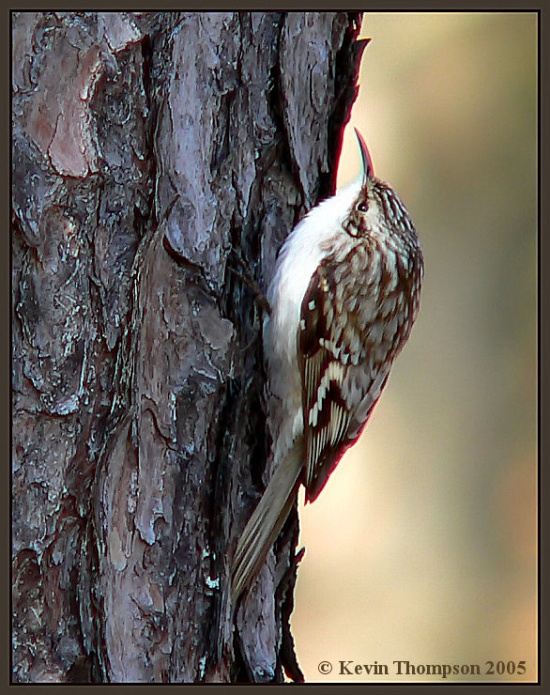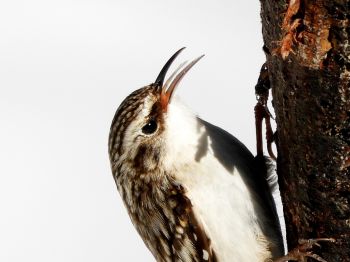
Alternative name: American Treecreeper.
- Certhia americana
Identification
5-5 3/4" (13-15 cm). Smaller than a sparrow.
A slender, streaked, brown bird, tinged with buff on flanks.
Distribution
Breeds from Alaska, Ontario, and Newfoundland southward throughout western mountains, Great Lakes region, North Carolina, and New England
Winters in breeding range and south to Gulf Coast and Florida.
Taxonomy
American Treecreeper is one of eight treecreepers in the genus Certhia; at least the two species in Europe are quite similar to the American species in also being cryptically patterned.
Subspecies[1]
Thirteen subspecies of Certhia americana are currently recognized:
- C. a. alascensis: South-central Alaska; winters to Arizona and New Mexico
- C. a. occidentalis: Coastal south-eastern Alaska to central California (south to Marin County)
- C. a. phillipsi: Resident in Coast Ranges of central California (San Francsico County s to San Luis Obispo County)
- C. a. stewarti: Haida Gwaii (British Columbia)
- C. a. montana: British Columbia to Cascades, the Dakotas, southern Arizona and western Texas
- C. a. zelotes: E slope of Cascades from S Oregon S through Sierra Nevada to mountains of N, E and S California and E to Nevada; non-breeding also Arizona and New Mexico.
- C. a. americana: Northern Saskatchewan to Newfoundland and north-eastern US; winters to Mexico
- C. a. idahoensis: Northern Idaho and north-western Montana to central Alberta; winters to Arizona
- C. a. nigrescens: Great Smoky Mountains of Tennessee and North Carolina
- C. a. albescens: Mountains of south-eastern Arizona, south-western New Mexico and north-western Mexico
- C. a. alticola: Mountains of southern Mexico
- C. a. pernigra: Mountains of extreme southern Mexico (Chiapas) and northern Guatemala
- C. a. extima: Mountains of eastern Guatemala, Honduras and north-western Nicaragua
Habitat
Deciduous and mixed woodlands.
Behaviour
This species is usually seen creeping up tree trunks, using its long, stiff tail for support
Breeding
The clutch consists of 6 or 7 white eggs, lightly speckled with brown, in a cup of bark shreds, feathers, sticks, and moss, usually placed against a tree trunk behind a peeling slab of bark.
Vocalisation
Call: A high-pitched, lisping tsee.
Song: A tinkling, descending warble.
References
- Clements, J. F., P. C. Rasmussen, T. S. Schulenberg, M. J. Iliff, T. A. Fredericks, J. A. Gerbracht, D. Lepage, A. Spencer, S. M. Billerman, B. L. Sullivan, and C. L. Wood. 2023. The eBird/Clements checklist of Birds of the World: v2023. Downloaded from https://www.birds.cornell.edu/clementschecklist/download/
- Poulin, J., É. D'Astous, M. Villard, S. J. Hejl, K. R. Newlon, M. E. McFadzen, J. S. Young, and C. K. Ghalambor (2020). Brown Creeper (Certhia americana), version 1.0. In Birds of the World (A. F. Poole, Editor). Cornell Lab of Ornithology, Ithaca, NY, USA. https://doi.org/10.2173/bow.brncre.01
Recommended Citation
- BirdForum Opus contributors. (2025) Brown Creeper. In: BirdForum, the forum for wild birds and birding. Retrieved 13 May 2025 from https://www.birdforum.net/opus/Brown_Creeper
External Links
GSearch checked for 2020 platform.1




